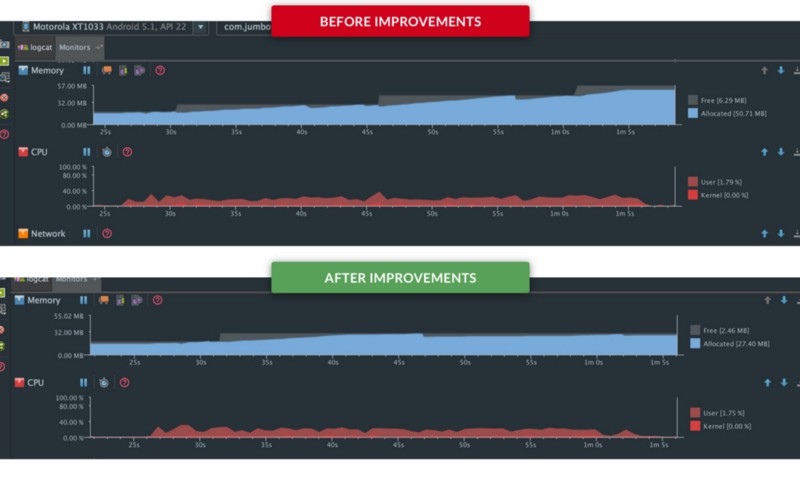
- Memory monitor always going up in android studio how to#
- Memory monitor always going up in android studio for mac#
- Memory monitor always going up in android studio code#
- Memory monitor always going up in android studio windows#
The Paths to Root tree shows the chain of objects that reference a type or instance. Selecting a type or instance displays the Paths to Root and Referenced Objects trees for the selected item. The Managed Memory tree shows the types and instances in the report. The Memory Usage tool displays these objects if they're involved in the ownership chains of your objects. NET, operating system, or compiler objects.
Memory monitor always going up in android studio code#
Types that you can't identify or whose involvement in your code you don't understand are probably. If an Object Type is blue, you can select it to navigate to the object in the source code, in a separate window. When you select one of the snapshot links in the Memory Usage overview page, a snapshot report opens in a new page. The total number of bytes in memory when the snapshot was taken.Select this link to display a snapshot details report sorted by the total size of the type instances. Select this link to display a snapshot diff report sorted by the difference in the total count of instances of the types. The difference between the total number of memory objects in this snapshot and the previous snapshot. It’s sorted by the difference in the total count of instances of the types. Select this link to display a snapshot diff report.

Select this link to display a snapshot diff report sorted by the difference in the total size of instances of the types. No Difference means the difference is zero. Baseline means a snapshot is the first in a diagnostic session. A positive number means the memory size of this snapshot is larger than the previous one, and a negative number means the size is smaller. The difference between the total size of memory objects in this snapshot and the previous snapshot. Select this link to display a snapshot details report sorted by the count of instances of the types. The total number of objects in memory when the snapshot was taken. Select this link to display a snapshot details report sorted by the total size of the type instances. The total number of bytes in memory when the snapshot was taken. To generate a report when you're done collecting or have taken snapshots, select Stop Collection.Īfter you stop data collection, the Memory Usage tool stops the app and displays the Memory Usage overview page. To stop a monitoring session without creating a report, just close the diagnostic window.

To collect snapshots, select Take snapshot when you want to capture the memory data. You can take another snapshot after the first occurrence of the problem, and additional snapshots if you can repeat the scenario. It's good to get a baseline snapshot of an app before a memory issue appears. You can take snapshots during a diagnostic session to capture memory usage at particular moments. Or, you may find memory issues to investigate.

Take snapshots of app memory statesĪn app uses a large number of objects, and you might want to concentrate your analysis on one scenario. This may indicate inefficient memory use or even a memory leak. Main concern is a rise in memory consumption that's not returned. Large spikes indicate areas that you can optimize. Spikes in the graph usually indicate that some code is collecting or creating data, and then discarding it when the processing is done. The timeline graph shows memory fluctuations as the app runs. When you start a diagnostic session, your app starts, and the Diagnostic Tools window displays a timeline graph of your app's memory use. Under Available Tools, select Memory Usage, and then select Start. On the menu bar, select Debug > Performance Profiler.
Memory monitor always going up in android studio windows#
In the Debug menu, set the solution configuration to Release and select Local Windows Debugger (or Local Machine) as the deployment target. NET, ASP.NET, C++, or mixed mode (.NET and native) apps. To start a Memory Usage diagnostic session:

For information on choosing the best memory analysis tool for your needs, see Choose a memory analysis tool.
Memory monitor always going up in android studio how to#
In this article, we show how to use the Memory Usage tool without the debugger in the Visual Studio Performance Profiler, which is recommended for release builds. The Memory Usage tool can run with or without the debugger. You can take detailed snapshots of the app's memory states, and compare snapshots to find the root causes of memory issues. You can use the tool to study the real-time memory effects of scenarios you're actively developing in Visual Studio. The Memory Usage tool monitors your app's memory use.
Memory monitor always going up in android studio for mac#
Applies to: Visual Studio Visual Studio for Mac Visual Studio Code


 0 kommentar(er)
0 kommentar(er)
